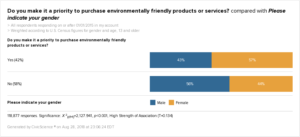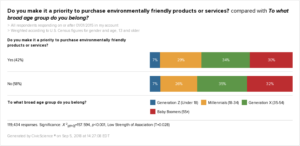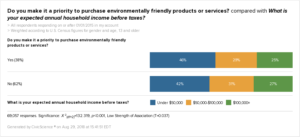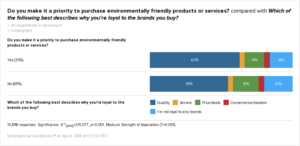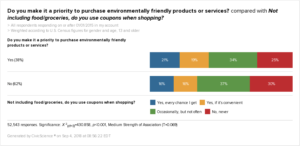One consumer sentiment trend that CivicScience tracks is preference towards certain types of products and services. With over 118,000 responses since 2015, we see that prioritization for purchasing environmentally friendly products is at an all-time high. Many brands have been recently moving in this direction – Adidas announced plans to use only recycled plastic in its products by 2024. Unilever recently announced a new eco-friendly beauty product line, and the largest cosmetic company in the world, L’Oréal, is frequently in the news for its focus on the environment.
Prioritizing eco-friendly products is not a universal sentiment, though. The majority, almost 60% of people in the U.S. say that when shopping, a brand’s environmental friendliness isn’t a priority while 42% say that it is.
While the majority of the U.S. says they don’t prioritize the environment in purchasing decisions, we do see a big change in consumer sentiment over time which indicates that this is a growing trend. People who say yes, eco-friendliness is a priority, rose from just under 30% to well over 40% from 2015 to today.
Our research shows that brands considering environmentally-friendly offerings may be looking to reach this particular target audience. CivicScience has developed a profile of what this segment of the population looks like.
Demographics
Gender
Women, who are the primary household shoppers, are much more likely than men to make eco-friendly products and services a priority when shopping. Of people who say yes, nearly 60% are women compared to 43% of men. Tailored messaging towards women should be a focus for brands looking to market any environmentally-friendly products or services. There also may be an untapped opportunity to reach more men.
Age
Contrary to popular belief, eco-friendly products aren’t just popular with the youngest generations. When comparing the ages of those who prefer eco-friendly products, Americans are pretty split. Gen Xers (ages 35-54) are the largest group of people in both categories. Millennials are the only generation more likely to say they do prioritize environmentally friendly products (29% compared to 26%).
Area
The type of area a person lives in may impact whether or not they make it a priority to make eco-friendly buying decisions. Of those who do, 40% live in the suburbs and 35% live in cities. Urbanites are more likely than not to make eco-friendly products a priority.
Income
Even though eco-friendly products are known to sometimes be more expensive, 46% of people who say they prioritize eco-friendly products make less than $50,000 in household income before taxes while 29% are in the $50,000-100,000 range. If brands want to reach this audience, affordability will play a role in a product line’s success.
Lifestyles
Early adopters
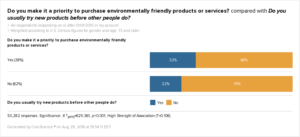
While the vast majority of the general population aren’t likely to be market mavens, people who try new products before most others do, there is a slight difference between both groups. People who prioritize buying eco-friendly products are more likely to be market mavens than those who don’t prioritize it. 32% of people who say environmentally friendly products are priority are typically among the first to try newer products compared to only 22% of people who don’t prioritize it.
Environmental concern
It’s no surprise that most people (49%) who say “Yes” try to help the environment by adjusting their daily lives and habits every chance they get, but a large chunk, 35%, say that they only will make lifestyle adjustments for the environment if it’s convenient enough. Brands who are following this path are challenged to make and promote products that are consistent enough with some of the more non-eco friendly alternatives that people may be currently buying.
Brand loyalty and price factors
Eco-friendly shoppers are more likely to care about brand loyalty – only 16% of those who responded “Yes” say they’re not loyal to brands compared to the 20% of the people who responded “No”. For people who prioritize environmentally friendly products, quality is by far the most important factor at 63% followed by price at 14%. While people who don’t prioritize environmentally friendly products are more likely to factor in price (18%) compared to those who do prioritize it, prices and offerings still are important for the eco-friendly crowd:
Of people who say they prioritize eco-friendliness of products, 21% use coupons every chance they get and 19% do if it’s convenient. Meaning that 40% of eco-conscious shoppers do use coupons compared to only 32% of people who say environmentally friendly products aren’t a priority.
Media consumption
Social media usage and influence
Eco-friendly shoppers spend less time on social media; the majority, 54%, either don’t use social media or only use it for less than 1 hour per day. However, 47% do spend at least 1 hour a day on social media. Your contacts and friends on social media can also make a difference:
Compared to people who don’t make eco-friendly products a priority, those who do are more likely to say that friends and contacts on social media influence the types of products they buy (35%). Given these two insights, social media still may be one channel to consider for promoting eco-friendly products.
CivicScience will keep tracking the eco-friendly shopping trend as it evolves, along with insights about customers who may be moving the needle on this trend.


